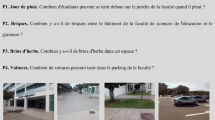Abstract
Our aim in this paper is toidentify factors affecting problem solvingstrategies in the case of a multiplicativecomparative situation, involving threeunknown quantities whose sum is known, andin which comparison relations between twopairs of the quantities are given. Wepropose a model of the complexity of a wordproblem about such situation. The model hasseveral variables, namely, 1) the ratio ofthe number of quantities that are beingcompared to the number of referencequantities (the `reference ratio'); 2) thescheme of the situation, i.e. the type ofrelation between the two given elementarycomparison relations; 3) the order ofpresenting the elementary comparisonrelations; 4) the words used to describethe multiplicative comparison relations (somany times `more' Vs so many times `less').The choice of the values of these variablesin the formulation of a problem is assumedto affect the solver's solution strategy.The most important construct of the modelis what we have called the `complexitylevel' of a solution, namely, the number ofoperations (theoretically) needed to gofrom the text of the problem to analgebraic representation of this solution.An analysis, in terms of the model, of wordproblems that can be formulated about thiskind of situation makes it clear that,while there are several options in solvinga given problem in algebraic terms, some ofthem are simpler (have a lower level ofcomplexity), from the formal standpoint,than others. In fact, the most efficientchoice for the independent variable is onewhich, in the scheme of the situation,stands in the position of the `connector'between the two elementary comparisonrelations. The model is used in analyzingsolution strategies of a set of twelveproblems about this type of multiplicativecomparative situation by 104 teachers and132 15 years old students. In particular,we identify their choices of theindependent variable and discuss theirsolutions in terms of levels of complexity.We also look at their preferences forinterpreting the texts of the problems interms of the word `more' rather than`less'. One of our observations is that,even if they were not aware of it, thesubjects in the study preferred solutionswith a minimal route. There were, however,some exceptions in cases where subjectspreferred to use the least value as theindependent variable, as well as totranslate the `less' relations into the`more' relations regardless of the highcomplexity of this solution.
Similar content being viewed by others
Author information
Authors and Affiliations
Rights and permissions
About this article
Cite this article
Nesher, P., Hershkovitz, S. & Novotna, J. Situation model, Text Base and what else? Factors affecting Problem Solving. Educational Studies in Mathematics 52, 151–176 (2003). https://doi.org/10.1023/A:1024028430965
Issue Date:
DOI: https://doi.org/10.1023/A:1024028430965



